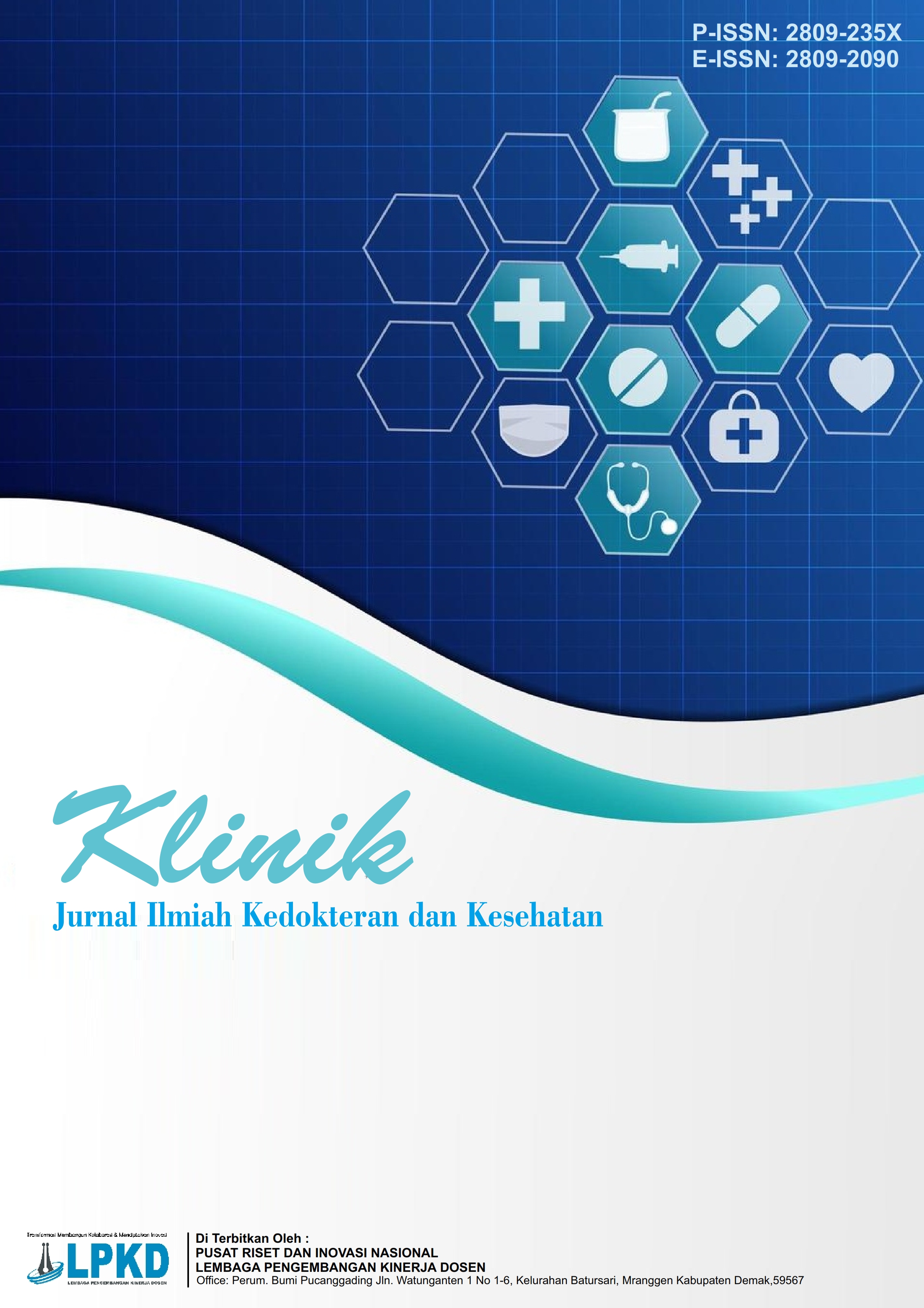Pemberian Infra Red dan Terapi Latihan pada Kasus Pasca Dislokasi Shoulder Sinistra
DOI:
https://doi.org/10.55606/klinik.v4i1.5126Keywords:
Dislocation, Hold-relax, Infrared, ShoulderAbstract
Shoulder dislocation is a fairly common musculoskeletal injury, particularly in individuals who engage in high-impact physical activity or sports involving extreme shoulder joint movements, such as athletes. This condition can cause significant pain, limited range of motion (ROM), decreased muscle function, and impact daily functional activities. Physiotherapy plays a crucial role in the rehabilitation process after a shoulder dislocation, with the primary focus being on reducing pain, restoring ROM, improving muscle function, and preventing recurrence. This study aimed to evaluate the effectiveness of a combination of infrared therapy and isometric hold-relax exercises in reducing pain and increasing ROM in patients with left shoulder dislocation. The study design used a case study approach with a single patient as the subject. The physiotherapy intervention consisted of six phased and scheduled sessions. Infrared therapy was administered to help relax muscle tissue, improve local blood circulation, and reduce pain intensity. Meanwhile, isometric hold-relax exercises were applied to increase muscle flexibility, expand ROM, and restore shoulder joint function. Evaluations were conducted before and after the intervention, measuring pain levels using a subjective pain scale and assessing range of motion (ROM) using a goniometer. The results showed a significant reduction in pain and a significant increase in joint mobility after undergoing the physiotherapy program. These findings indicate that the combination of infrared therapy and isometric hold-relax exercises can be an effective method in shoulder dislocation rehabilitation, supporting functional recovery and potentially reducing the risk of re-injury. This study also emphasizes the importance of a multimodal therapeutic approach in the management of musculoskeletal injuries for optimal outcomes.
References
Ackerman, I. N., Fotis, K., Pearson, L., Schoch, P., Broughton, N., Brennan-Olsen, S. L., Bucknill, A., Cross, E., Bunting-Frame, N., & Page, R. S. (2022). Impaired health-related quality of life, psychological distress, and productivity loss in younger people with persistent shoulder pain: A cross-sectional analysis. Disability and Rehabilitation, 44(15), 3785–3794. https://doi.org/10.1080/09638288.2021.1887376
Atmaja, D. P., & Ghurri, A. (2023). Penatalaksanaan fisioterapi pada kasus low back pain miogenik dengan metode infrared dan massage. STAMINA, 6(2), 45–50. https://doi.org/10.24036/JST.V6I2.1189
Belk, J. W., Wharton, B. R., Houck, D. A., Bravman, J. T., Kraeutler, M. J., Mayer, B., Noonan, T. J., Seidl, A. J., Frank, R. M., & McCarty, E. C. (2023). Shoulder stabilization versus immobilization for first-time anterior shoulder dislocation: A systematic review and meta-analysis of Level 1 randomized controlled trials. The American Journal of Sports Medicine, 51(6), 1634–1643. https://doi.org/10.1177/03635465211065403
Cho, H. Y., Heijnen, M. J. H., Craig, B. A., & Rietdyk, S. (2021). Falls in young adults: The effect of sex, physical activity, and prescription medicat ions. PLOS ONE, 16(4), e0250360. https://doi.org/10.1371/journal.pone.0250360
De Cristofaro, L., Brindisino, F., Venturin, D., Andriesse, A., Pellicciari, L., & Poser, A. (2025). Prognostic factors of nonsurgical intervention outcomes for patients with frozen shoulder: A retrospective study. Disability and Rehabilitation, 47(3), 719–726. https://doi.org/10.1080/09638288.2024.2360044
Fares, M. Y., Boufadel, P., Daher, M., Koa, J., Khanna, A., & Abboud, J. A. (2023). Anterior shoulder instability and open procedures: History, indications, and clinical outcomes. Clinics in Orthopedic Surgery, 15(4), 521–530. https://doi.org/10.4055/CIOS23018
Gottlieb, M., Patel, D., Marks, A., & Peksa, G. D. (2022). Ultrasound for the diagnosis of shoulder dislocation and reduction: A systematic review and meta-analysis. Academic Emergency Medicine, 29(8), 999–1007. https://doi.org/10.1111/acem.14454
Gusma, K. C. (2022). Survei penyebab terjadinya cedera anterior cruciate ligament (ACL) pada Komunitas ACL Indonesia cabang Jateng DIY. Unnes Journal of Sport Sciences, 6(2), 104–117. https://doi.org/10.15294/UJOSS.V6I2.54852
Hapsari, H. D., & Imania, D. R. (2016). Perbedaan pengaruh penambahan proprioseptif neuromuscular facilitation (PNF) stretching hold relax pada intervensi ultrasound terhadap nyeri plantar fasciitis di SMP N 1 Sambirejo Sragen. http://lib.unisayogya.ac.id
Kelly, M. J., Holton, A. E., Cassar-Gheiti, A. J., Hanna, S. A., Quinlan, J. F., & Molony, D. C. (2019). The aetiology of posterior glenohumeral dislocations and occurrence of associated injuries. Bone and Joint Journal, 101-B(1), 15–21. https://doi.org/10.1302/0301-620X.101B1.BJJ-2018-0984.R1
Lear, A., & Patel, N. (2016). Softball pitching and injury. Current Sports Medicine Reports, 15(5), 336–341. https://doi.org/10.1249/JSR.0000000000000293
Nakamura, M., Sato, S., Kiyono, R., Yahata, K., Yoshida, R., Fukaya, T., & Konrad, A. (2021). Comparison of the acute effects of hold-relax and static stretching among older adults. Biology, 10(2), 126. https://doi.org/10.3390/biology10020126
Pan, X., Yao, Y., Yan, H., Wang, J., Dai, L., Qu, X., Fang, Z., Feng, F., & Zhou, Y. (2021). Iatrogenic fracture during shoulder dislocation reduction: Characteristics, management and outcomes. European Journal of Medical Research, 26(1), 1–7. https://doi.org/10.1186/s40001-021-00545-3
]Provencher, M. T., Midtgaard, K. S., Owens, B. D., & Tokish, J. M. (2021). Diagnosis and management of traumatic anterior shoulder instability. Journal of the American Academy of Orthopaedic Surgeons, 29(2), e51–e61. https://doi.org/10.5435/JAAOS-D-20-00202
Purna Atmaja, D. (2023). Treatment of neck muscle pain and tension with TPG therapy. Jurnal EduHealth, 14(1), 320–324. https://ejournal.seaninstitute.or.id/index.php/healt/article/view/1545
Purna Atmaja, D., Ghurri, A., Andriana, L. M., Rosanti, D. P., Ningrum, S., & Kesehatan, F. I. (2024). Penyuluhan tata laksana penanganan pasien pasca cedera sebagai upaya pelayanan kesehatan pada siswa-siswi SMK di wilayah Kecamatan Krian. Jurnal Pengabdian Kepada Masyarakat, 3(4), 37–42. https://doi.org/10.55606/JPKM.V1I4.69
Romano, A. M., Edwards, T. B., Nastrucci, G., Casillo, P., Di Giunta, A., Zappia, M., Susanna, M., & Ascione, F. (2021). Arthroscopic reduction and subscapularis remplissage (ARR) of chronic posterior locked shoulder dislocation leads to optimized outcomes and low rate of complications. Knee Surgery, Sports Traumatology, Arthroscopy, 29(7), 2348–2355. https://doi.org/10.1007/s00167-020-06317-6
Shah, M., Shah, S., Sangole, C., Bansal, S., Naik, N., & Patel, T. (2023). Clinical diagnosis of the infantile shoulder subluxation in residual brachial plexus birth injury and its correlation with ultrasound diagnosis. Journal of Pediatric Orthopaedics, 43(2), 123–127. https://doi.org/10.1097/BPO.0000000000002311
Søgaard, K., & Sjøgaard, G. (2017). Physical activity as cause and cure of muscular pain: Evidence of underlying mechanisms. Exercise and Sport Sciences Reviews, 45(3), 136–145. https://doi.org/10.1249/JES.0000000000000112
Szyluk, K., Niemiec, P., Sieroń, D., Lukoszek, D., Gierek, M., Lorek, A., & Christe, A. (2022). Shoulder dislocation incidence and risk factors—Rural vs. urban populations of Poland. International Journal of Environmental Research and Public Health, 19(19), 11857. https://doi.org/10.3390/ijerph191911857
Yin, R. (2018). Case study research and applications (6th ed.). Sage.
Zhu, Q., Xiao, S., Hua, Z., Yang, D., Hu, M., Zhu, Y.-T., Zhong, H., & And, R. (2021). Near infrared (NIR) light therapy of eye diseases: A review. International Journal of Medical Sciences, 18(1), 109–119. https://doi.org/10.7150/ijms.52980
Downloads
Published
How to Cite
Issue
Section
License
Copyright (c) 2025 Jurnal Ilmiah Kedokteran dan Kesehatan

This work is licensed under a Creative Commons Attribution-ShareAlike 4.0 International License.








